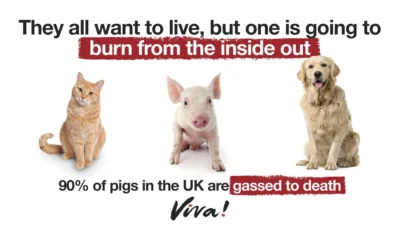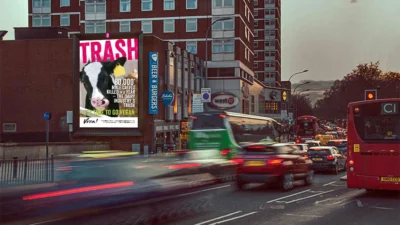White meat gets a “black mark’ in school dinners
PARENTS in Cheltenham are being warned about the dangers of feeding their children white meat, as a new report reveals it can increase risk of cancer and diabetes in later life. White Meat Black Mark, from health charity the Vegetarian & Vegan Foundation (VVF), found thoroughly cooking white meat, including chicken, duck and turkey, can generate hazardous chemicals known as HAAs (1), which are linked to cancer in humans (2). The VVF is calling on Gloucestershire Local Education Authority (LEA) to reduce or remove the amount of all meat – including white meat – from local school meals. PHOTO: Charlie the giant VVF chicken will be in Regent Arcade with the VVF team handing out FREE healthy lunch packs and information. He will giving a “bad LEA representative’ dressed in a suit and dunce hat, a “black mark’ (with a cane) for allowing white meat to remain on school menus. But he has a serious message. To slash your family’s risk of food poisoning, diabetes, obesity and cancers, the safest option is to go veggie. Author of the White Meat Black Mark report, VVF senior nutritionist, Amanda Woodvine, says: “The fact that white meat is still perceived to be a low-fat, high protein food, desirable for health is outrageous. We urge the LEA to remove it from school menus. White meat contains more than twice as much fat as it did in 1940 – a third more calories and a third less protein. Meat – including white meat, is the one food most linked to weight gain around the waist.” (4) She added: “It is not compulsory for school children to be offered meat, as long as alternative food sources of protein are on the menu. For nursery and primary school children, one item from this food group must be offered each day, rising to two items a day for those at secondary school. “Alternative sources of protein include soya products (eg tofu, veggie mince), pulses (eg baked beans, chickpeas, kidney beans, lentils), nuts and seeds. Bean burritos, Spaghetti Bolognese made with veggie mince, and vegetable soup with added lentils all go down well with children. Diets based around these foods are much lower in harmful cholesterol, saturated fat and total fat, and higher in fibre.” To order copies of the resources and for more information about the White Meat Black Mark campaign, visit www.vegetarian.org.uk or call 0117 970 5190. To find out about meat reducing, or becoming veggie or vegan, visit www.vegetarian.org.uk. ENDS For more information about this media release, please contact press officer Helen Rossiter vvfpress@vegetarian.org.uk or Amanda Woodvine amanda@vegetarian.org.uk or call 0117 970 5190. On the day, call 07977 463057. Images will be available upon request after the photo call. Notes to Editors Gloucestershire LEA has been offered further information about the risks eating meat can pose to pupils, plus help and advice about providing tasty, nutritious, plant-based alternatives. As part of the White Meat Black Mark campaign, the VVF has produced: – a fully referenced scientific report White Meat Black Mark, uncovering the truth about the health consequences of eating chicken, duck, turkey and goose; – a colourful easy-to-read guide White Meat Myths, explaining why white meat is not the healthy option for adults or children, including exciting recipes using meat alternatives. A team of researchers at London Metropolitan University found that a chicken carcass contains almost a pint of fat. This is the fat found throughout the bird’s tissues, rather than the sort which runs off into the grill pan as the bird is cooked. Even by removing the skin and scraping away the subcutaneous fat stuck to meat, you cannot entirely avoid it (3). References (1) HAA stands for heterocyclic aromatic amines (2) US Department of Health and Human Services, Public Health Service, National Toxicology Programme, 2005. 11th report on carcinogens. Available at http://ntp.niehs.nih.gov/ntp/roe/toc11.html (3) Wang YQ, Thomas B, Ghebremeskel K and Crawford MA, 2004. Changes in Protein and Fat Balance of Some Primary Foods: Implications for Obesity? Institute of Brain Chemistry and Human Nutrition (IBCHN). London Metropolitan University (4) Kahn, H.S. et al., 1997. Stable behaviors associated with adults’ 10-year change in body mass index and likelihood of gain at the waist. American Journal of Public Health. 87 (5) 747-54 New research suggests that eating just one or more servings of meat (any type) per week significantly increases your risk of diabetes. People eating a “low-meat’ diet for 17-years had a staggering 74 per cent increase in their risk of developing diabetes. HAAs are produced during the cooking of many animal products, including chicken, beef, pork and fish. In January 2005, the US Federal Government officially added HAAs to its list of known carcinogens. Skinless, boneless chicken breast is one of the five worst foods to grill, producing more HAAs than steak, pork, salmon or hamburgers. Non profit organisation, the Physicians Committee for Responsible Medicine (PCRM) recently filed a lawsuit in the USA over carcinogens in grilled chicken. To claim there is a “safe’ dose of HAAs is irresponsible, particularly where children are concerned. Chicken is the main source of food poisoning in Europe. Those most endangered by food poisoning are the elderly, pregnant women and children under one year old, but anyone can suffer. Depending on the contaminant, fever and chills, bloody stools, dehydration, and nervous system damage may follow. A massive 95 per cent of all food poisoning cases are caused by eating animal products. Department for Children, Schools and Families http://www.dcsf.gov.uk/schoollunches/infants.shtml http://www.dcsf.gov.uk/schoollunches/juniors.shtml http://www.dcsf.gov.uk/schoollunches/secondary.shtml The launch comes the week after a private school in Gloucestershire announced it is seeking sixth form pupils to take up a special vegetarian scholarship. http://news.bbc.co.uk/1/hi/england/gloucestershire/7885369.stm




